The Association for Mormon Letters Awards were presented at Brigham Young University, March 23, 2018.
Lavina Fielding Anderson was presented with the Smith-Pettit Foundation Award for Outstanding Contribution to Mormon Letters.
Robert Kirby was presented with the Association for Mormon Letters Lifetime Achievement Award.
The finalists and winners of the following awards were selected by panels of judges who are experts in the respective fields.
Anthology
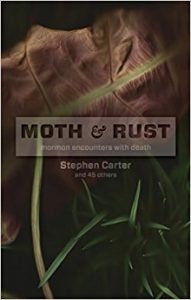 Moth and Rust: Mormon Encounters with Death. Stephen Carter, editor. Signature.
Moth and Rust: Mormon Encounters with Death. Stephen Carter, editor. Signature.
Death comes into our lives all too often; we don’t seek it out. As much as possible, we focus on essential, everyday concerns and keep death in the distance, at the edge of the horizon. Consequently, it is something of an anomaly to find an anthology whose organizing subject is death. This remarkable volume includes personal essays, informational essays, experimental essays, sermons, stories, poems, a play, and a piece of visual art. Carter has done an extraordinary job of weaving all these genres together so that in turning to the next piece, the reader is surprised and has to adjust expectations for how the narrative will develop. There are such a variety of responses to death that each reader will find some pieces to fit and others to challenge his or her paradigm of what happens at death, of how the dead interact with the living, and of how we create meaning in or come to an acceptance of this mortal experience that ultimately awaits us all. The volume is original and extremely well-written, and the authors’ musings about and personal experiences with death have left us with much to consider.
Other finalists:
Seasons of Change: Stories of Transition from the Writers of Segullah. Shelah Mastny Miner and Sandra Clark Jergensen, editors. Peculiar Pages.
States of Deseret. Wm Morris, editor. Peculiar Pages.
Comics
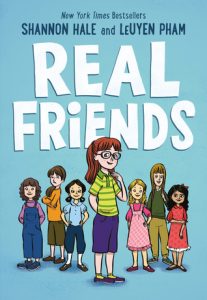 Real Friends, by Shannon Hale and LeUyen Pham. First Second/Roaring Brook.
Real Friends, by Shannon Hale and LeUyen Pham. First Second/Roaring Brook.
Shannon Hale’s Real Friends is the rare middle-grade memoir that is unafraid to lean in to how disorienting and unpleasant childhood can be at times while still remaining fully accessible to its target audience. As the title implies, the main narrative follows Hale’s experiences with both real and false friends during elementary school, but also explores her home life, Mormonism (including a sequence where she imagines that Jesus is with her on the playground after she is abandoned by her former best friend), and challenging relationship with a hot-tempered older sister. Pham’s artwork is a perfect match for Hales story-spinning, and truly shines during sequences in which Hale’s childhood imagination runs wild, converting herself and her friends into Dallas Cowboy’s cheerleaders, superheroes, and noir detectives. Throughout, Hale’s story is often heartrendingly familiar. We, the judges, second Pham’s assertion that “somehow [Shannon Hale] crawled inside my memories and handpicked all these events and feelings and insecurities from my childhood and called them [her] own.” We are grateful for the change to relive those memories through this work, though the recognition and enjoyment are tinged with pain.
Other Finalists:
Batman ’66/Legion of Super Heroes #1, by Lee Allred, Michael Allred, and Laura Allred. DC Comics
The Garden of Enid: Adventures of a Weird Mormon Girl, Vol. 2, by Scott Hales. Kofford Books
Comic Diaries, by Brittany Long Olsen
Necropolis, by Jake Wyatt and Kathryn Wyatt
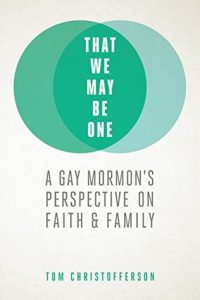 Creative Non-Fiction
Creative Non-Fiction
That We May Be One: A Gay Mormon’s Perspective on Faith and Family, by Tom Christofferson. Deseret Book
With That We May Be One, Tom Christofferson offers us an extraordinary account of his life-long journey of reconciling his sexuality and his religion. The result is a vulnerable and openhearted book that is written with a generosity of spirit, clarity of purpose, and a fragmented loyalty to his gay and Mormon identities. Regardless of the difficulty, his family’s practice of learning to love unconditionally forms the powerful backbone of the narrative in the context of a church that places so much emphasis on the nuclear family. The book normalizes a serious engagement of marginalized sexual identities with Mormon doctrine and practice and insists on the legitimacy of the attendant spiritual authority. Christofferson invites us to be with him at this point of intersection, not because the tension between these identities is resolved, but to help us acknowledge that they exist and are individually constituted. Christofferson’s account prompts us to see the magnitude of sexual identity and to listen respectfully to people outside the heteronormative experience.
Other finalists:
Learning to Like Life: A Tribute to Lowell Bennion. by George B. Handley. Self
The Burning Point, by Tracy McKay. BCC Press
Open Midnight: Where Ancestors and Wilderness Meet, by Brooke Williams. Trinity University Press
Criticism
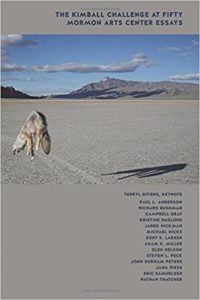 “The Second Coming of Mormon Music,” by Michael Hicks. From The Kimball Challenge at Fifty: Mormon Arts Center Essays.
“The Second Coming of Mormon Music,” by Michael Hicks. From The Kimball Challenge at Fifty: Mormon Arts Center Essays.
A highlight in the already-loaded collection The Kimball Challenge at Fifty: Mormon Arts Center Essays, Michael Hicks’ article “The Second Coming of Mormon Music” is the one that comes the closest to feeling like a bona fide sermon — while still being a critical essay — while still transcending both categories. Indeed, transcendence is the overriding call-to-arms of this article: transcending the boundaries between maps, between historical periods, between faiths, between people. He takes Spencer W. Kimball’s 1967 call for a Mormon artistic Renaissance seriously — so seriously, in fact, that he considers that initial call too limiting. For Hicks, the Prophet’s examples of “Great Art” were far too Eurocentric and pre-modern — that is, far too bound in space and time. Taking Christ Himself as his central metaphor, Hicks both sees and seeks for a Mormon music that is as omnipresent and all-encompassing as the Second Coming will be.
Other finalist:
“On the Problem and Promise of Alex Caldiero’s Sonosophy: Doing Dialogical Coperformative Ethnography; Or, Enter the Poetarium,” by Tyler Chadwick. PhD Dissertation, Idaho State University
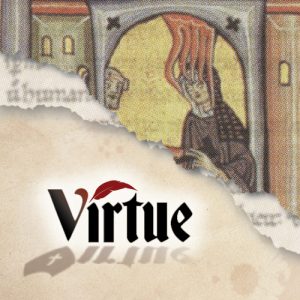 Drama
Drama
Virtue, by Tim Slover. Plan-B Theatre Company.
Tim Slover’s Virtue is a work of beauty and intelligence. The play is designed to move seamlessly, layering time, space, and dialogue, creating meaning within meaning. This strong sense of theatricality serves to deepen the story of Hildegard of Bingen, as she becomes aware of the space between received morality and her own experiences with love, divinity, and inspiration. That space, where the love of God clashes with the feeling of being cut off, is where the conflict of the play lives. It is both heart-wrenching and beautiful. But as the play shows us, that space can also be an opening for new light, an acre of grace.
Not One Drop, By Morag Shepherd. Plan-B Theatre Company.
The Drown’ed Book, or the History of William Shakespeare, Part Last, by Mahonri Stewart. Zion Theatre Company.
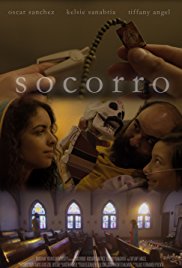 Film
Film
Socorro. Marshal Davis, writer and director
Marshal Davis’ Socorro pulls off an impressive feat: it is emotionally and spiritually earnest without feeling particularly manipulative, campy, or preachy. In Socorro, a loving father tries to save his ailing daughter, and he reaches to divine sources for help. Throughout the film, we see moments of both transcendence and immanence treated with equal reverence: overtly religious iconography sits side-by-side with signifiers of a subtler, lived religion. And the lines between mundanity and profundity are often blurred. Questions about faith and miracles shift easily to become conversations about kind, attentive nurses and beautiful thank-you cards. Moments of quiet contemplation are imbued with a sense of numinous, holy ritual. For example, there is one scene during which a man and woman sit on a hospital couch, sharing food and drink. As he passes a tamale into her hands, we can’t help but notice the stillness of the camera, the gentleness of the performances, and the warmth of the lighting, all culminating in the feeling that this is a moment of sacred communion. A second later, he hands her a plastic cup of Sangría Señorial, carefully and quietly, like a cup of sacramental wine. These connections are never made explicit, never spelled out for us—it’s not a metaphor—but the film wants us to deeply immerse in the texture of the scene. In a hospital, one feels a strange mixture of agony and love, of uncertainty and peace, of panic and quiet, of fatigue and rest, of disgust and reverence, of faith and despair: these are the same feelings we wrestle with at church. They are the feelings that surround questions about life and death, about sin and salvation, about doubt and regret and hope. They are the feelings of discipleship. And the best thing about Socorro is that it allows us to feel all of them, without judgment or condescension. Which is to say, it allows us to explore the complexity and difficulty of succoring and of being succored. The film is therefore an admirably nuanced, honest, and warm-hearted piece of work, and in a very real sense, it is a Comforter.
Other finalists:
The Man in the Camo Jacket. Written and directed by Russ Kendall.
Out of the Ground. Written and directed by Barret Burgin.
A Pug & Wolf Christmas. Created by Davey and Bianca Morrison Dillard.
We Love You, Sally Carmichael! Directed by Christopher Gorham, written by Daryn Tufts.
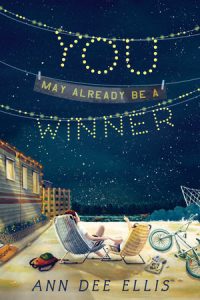 Middle Grade Novel
Middle Grade Novel
You May Already Be A Winner, by Ann Dee Ellis. Penguin
You May Already Be A Winner, Ann Dee Ellis’ first middle grade novel, tells the poignant story of a young girl who’s desperate to bring a little luck into her life. Every day, 12-year-old Olivia enters multiple sweepstakes and prays for a lucrative win. All she needs is one million dollars—with that kind of money, her mother could quit her exhausting dead-end job; her father would come back home; and Olivia wouldn’t have to miss school to watch her sister. If she could already be a winner like the contests promise, life would be perfect again. But that’s not the way things work at dumb bum Sunny Pines Trailer Park. As Olivia soon learns, sometimes you have to make your own luck.
Original and affecting, You May Already Be A Winner is an unforgettable novel that will sink deep into your heart. Olivia is a sympathetic heroine with a strong voice and a big imagination, a girl who’s both spunky and self-deprecating. While her emotions are raw and real, Ellis describes them in a way that is authentic, funny, and, ultimately, hopeful. Its unique narrative style vividly captures the terrifying uncertainty of an off-kilter childhood. With a perfect blend of heft and humor, it’s a standout among its peers and more than deserving of this award.
Other finalists:
Under Locker and Key, by Allison K. Hymas. Aladdin
Mustaches for Maddie, by Chad Morris and Shelly Brown. Shadow Mountain
Forget Me Not, by Ellie Terry. Feiwel & Friends
Paper Chains, by Elaine Vickers HarperCollins
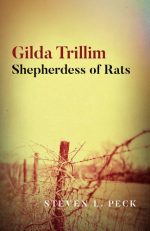 Novel
Novel
Gilda Trillim: Shepherdess of Rats, by Steven L. Peck. Roundfire Books.
What if whatever it was Orson F. Whitney once said about Mormon literature was realized, and we could finally claim someone like a Shakespeare or a Milton of our own? And what if that writer was, for the most part, mad—more of a William Blake than a William Wordsworth, more of a James Joyce than a Jane Austen? This is the title character of Steven L. Peck’s Gilda Trillim: Shepherdess of Rats. She is brought to life through Peck’s skill as a write and thinker, and through his audacity—challenging and provoking the reader, and particularly the Mormon reader, in strange, original ways. Rich and unexpected, the novel explores universal themes of grace, love, sacrifice as well as universal questions about the mind and body, free will, and how anything is known–including and the reality and nature of god. This is achieved through the well-wrought interplay of poetry, philosophy, narrative, and the artful posing of the same devastating questions we have all asked ourselves.
Gilda Trillim has already been called “a milestone of Mormon literature.” This is true not just for its message but for its medium, harnessing the form of the novel to show that imagination can bring us closer to truth. Fiction is a faculty, helping us transcend the limitations of our natural understandings and perceptions. Odd, complex, and unprecedented, Peck’s Gilda will stand out in Mormon literature not just this year, but for many years.
Other finalists:
Claire Åkebrand, The Field is White. KERNPUNKT Press
Brian McClellan, Sins of Empire. Orbit
Luisa Perkins, Prayers in Bath. Mormon Artists Group
Dan Wells, Nothing Left to Lose. Tor
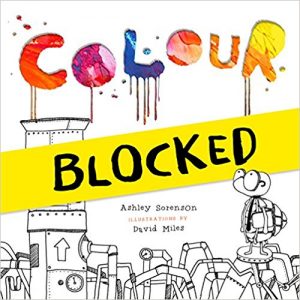 Picture Book
Picture Book
Color Blocked, written by Ashley Sorenson and illustrated by David Miles. Familius
Color Blocked is an inventive twist on the traditional color-mixing principles book. Its quirky, cartoon-style illustrations combine with bold colors and interactive text to make for an engaging read for toddlers and elementary aged kids. Its sturdy construction promises that it will be a book you and your child can read again and again. Following in the same vein as Herve Tullet’s Press Here, this is an excellent offering from Familius Publishing.
Other finalists:
Heroic Stories from The Book of Mormon, by Shauna Gibby and Casey Nelson. Deseret Book
Quiet as a Church Mouse, by Stephen Bevan and Jeff Harvey. Cedar Fort
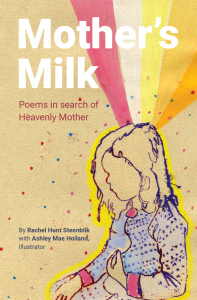 Poetry
Poetry
Mother’s Milk: Poems in Search of Heavenly Mother. By Rachel Hunt Steenblik, with illustrations by Ashley Mae Hoiland. BCC Press
Rachel Hunt Steenblik’s Mother’s Milk should be required reading for every Mormon feminist, and likely for every Mormon. In spare, elegant verse she explores the complicated, emotional doctrine of Heavenly Mother, and she asks a lifetime of questions in 145 pages. She draws out these questions and sketches answers by casting a wide net through the world: she references everything from picture books to Kierkegaard, from canonical scripture to her children’s prescient comments, from her own imaginings of Heavenly Mother’s nature to ancient depictions of the Mother Goddess. And she’s kept meticulous, fruitful track of her path: the “Notes” section at the back of the book is almost as delicious as the poetry. It’s no coincidence that the verbs “draw” and “sketch” come to mind. The accompanying illustrations by Ashley Mae Hoiland perfectly mirror Steenblik’s longing, and the comfort she finds in quotidian earthly echoes of divine motherhood. The faces in Hoiland’s illustrations are featureless, and this artistic choice beats at the center of this beautiful book: any of these women could be our Heavenly Mother, any of them could be us. The possibility of reflection, the opportunity for a Mormon woman to begin to see herself created in God’s image in a newly literal sense: this is the astonishing, culture-shifting gift of Mother’s Milk.
Other finalists:
Babbage’s Dream. By Neil Aitken. Sundress Publications
What Was Left of the Stars. By Claire Åkebrand. Serpent Club Press
Ephemerist. By Lisa Bickmore. Red Mountain Press
Owning the Moon. By Linda Sillitoe. Signature Books
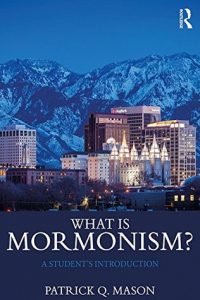 Religious Non-Fiction
Religious Non-Fiction
What is Mormonism? A Student’s Introduction, by Patrick Q. Mason. Routledge
The category of religious nonfiction is decidedly broad within the world of Mormon publications: this year, our finalists ranged from a poetic paraphrase of a biblical love poem to an ambitious consideration of Mormon ecclesiology. But it was Patrick Mason’s careful, concise, yet comprehensive approach in What is Mormonism: A Student’s Introduction that ultimately stood out.
Mason provides an excellent introduction to the history, devotional practices, beliefs, and contemporary issues that face the Church of Jesus Christ of Latter-day Saints. The book does not shy away from difficult or odd subjects, whether they be historical (a vision of God? translating gold plates by placing stones in a hat? the deaths of Mormon children at the hands of a Missouri militia?), cultural (racism? imperialism? sexism?), or doctrinal (Godhead rather than Trinity? eternal family relationships? theosis?). For example: the respectful yet matter-of-fact discussion of temple ordinances and the way these practices fit within, witness, and even constitute the Mormon understanding of exaltation takes place within a mere six pages, yet is expertly done such that any reader cannot help but walk away with a cogent understanding as to why temples play such a significant role in individual Mormon lives as well as within the organization of the Church itself. It is a discussion equally beneficial to non-members and members alike.
The pragmatic clarity Mason employs throughout the volume has produced a volume that can be profitably read by those within and without the LDS Church. Mormonism is described in a secular, undergraduate-level academic language in a way that is recognizable and intelligible both to those within the academy (students/scholars) and those within Mormonism. This careful balance creates a volume positioned to significantly impact the possibilities for future conversations on Mormonism both within and without the faith. Mason brings a fresh vocabulary to well-tread topics through his consistently well-crafted and conceived volume. For all these reasons, we are pleased to award the 2017 Association for Mormon Letters Award for Religious Non-Fiction to Patrick Mason’s What is Mormonism.
Other finalists:
Feeding the Flock: The Foundations of Mormon Thought: Church and Praxis, by Terryl L. Givens, Oxford University Press
The Sun Has Burned My Skin: A Modest Paraphrase of Solomon’s Song of Songs, by Adam S. Miller. BCC Press
Perspectives on Mormon Theology: Apologetics. Blair G. Van Dyke and Loyd Isao Ericson, editors. Greg Kofford Books
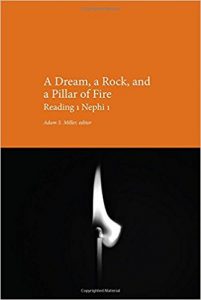 Special Award in Religious Non-Fiction Publishing
Special Award in Religious Non-Fiction Publishing
“Proceedings of the Mormon Theology Seminar”, published by the Neal A. Maxwell Institute for Religious Scholarship’s Mormon Theology Seminar, Adam S. Miller, director.
It is with pleasure that we present an award of special recognition to the Mormon Theology Seminar and the Neal A. Maxwell Institute for Religious Scholarship for the series “Proceedings of the Mormon Theology Seminar.” The three volumes of the series that appeared in 2017—Fleeing the Garden: Reading Genesis 2–3, A Dream, A Rock, and a Pillar of Fire: Reading 1 Nephi 1, and Embracing the Law: Reading D&C 42—each continue the tradition established by the preceding volumes in the series of providing a collection of thought-provoking, creative, and careful close readings of the scriptural text under consideration. The breadth and depth of the scholarship behind this endeavor, along with its commitment to collaborative, cross-disciplinary readings are to be commended.
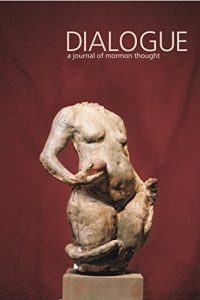 Short Fiction
Short Fiction
“The Pew” by Alison Maeser Brimley. Dialogue, 50:3, Fall 2017.
“The Pew” tells the story of a skirmish between a committee of women and their male leaders over the demolition of a pioneer-era tabernacle in a fictional Southern Utah town. However, the story is just as much about the friendship between two women, Helen and Inez, who are kitchen-window neighbors; when the blinds are up, they can see each other while they talk on the phone. It also deals with the tension between Helen and her husband, Inez and the stake president, tensions that affect everyone in town because they all relate variously to the central building in town, the tabernacle, built by the town’s founder. Through this network of relationships the story becomes the tensional model of a traditional Mormon community. Brimley’s gift is imagining herself into the soul of another people, another time, when women were told by their mothers, “You can either be right or you can be happy.”
Frandsenville could stand in for many Utah towns: it was settled by Danish Saints and built of sandstone in a Victorian Gothic style. Women made 200 quilts to sell, and children sold beets to help pay for the building. A Swede who spoke no English painted a mural on the ceiling; stained glass was brought in on the new rail line. Before the dedication the wood floor was scrubbed with homemade soap. The story of the creation of the tabernacle is “woven inside [them] like a strand of his or her own DNA.” Brimley portrays the building as the spiritual, emotional, and geographical center of this fictional community, which, like actual communities, are weaved out of repeated stories.
Inez, the older of the two friends, treasures the building, and asks Helen to help her fight the stake presidency and high council. What begins as a service to her friend is soon Helen’s passion, one that started as “a little singe of sadness on her skin like touching a hot bread pan.” The conflict is between individual will and inspiration and authoritative will and inspiration, certainly both a Mormon and an American tension. It’s also a conflict between two ways of seeing the City of God, as existing for the people or for the leaders. Inez says, “It’s not his building. It’s our building—it’s Frandsenville’s.” The stake president and the high council say, “It’s the Lord’s.”
The narrative shifts between various times and perspectives, using techniques that are traditionally aligned with novels. The story begins when Helen is 84, shuttles back to a time 45 years earlier when Inez was 84 during the time of the spat over the building, and further back to a time when the tabernacle was built. To this warp of time is bound the weft of perspective as we shift from the primary point of view inside Helen’s head, to an omniscient view of the tabernacle’s construction, to the perspective of Helen’s husband, and to the stake president. The rhythmic images of self and other also blend to create a virtual community in imitation of historical communities.
Brimley uses a traditional realistic form, but with a consciousness of such experimental techniques as narratives layered inside narratives, rhythms of image and coincidence that are known to the characters, multiple perspectives in counterpoint, a timespan that is more suited to longer forms, and the use of such objects as the eponymous pew as a sign with multiple signifieds. “The Pew” is woven from tradition, but it transcends tradition.
Other finalists:
R.A. Christmas. “Le Train à Grande Vitesse”. Dialogue, 50:1, Spring 2017
Bradeigh Godfrey. “The Thicket”. Sunstone, 185. Summer 2017
Heidi Naylor. “Jane’s Journey”. Sunstone, 185. Summer 2017
Steven L. Peck. “Bishop Johansen Rescues a Lost Soul: A Tale of Pleasant Grove”. Dialogue, 49:4. Winter 2016
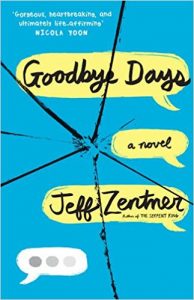 Young Adult Novel
Young Adult Novel
Goodbye Days, by Jeff Zentner. Random House
There is a reason Jeff Zentner’s Goodbye Days is winning and being nominated for various awards. It’s timely. It’s real. It’s heartbreaking and healing all at once. Benjamin Alire Sáenz calls it “Tender, honest, moving and lyrical…” We concur with this sentiment. Readers experience the loss of friends, brothers, and sons with all the different flavors of grief, anger, denial, and hope. Zentner writes about Carver, the main character, guilt and subsequent panic attacks with vicious, vivid detail, but balances the story with delightful—and sometimes hilarious—flashbacks of life prior to the accident. In short, it’s a near-perfect blend of light and dark, despair and deliverance, and it deserves to be recognized with the 2017 AML Young Adult Novel Award.
Other finalists:
McKell George. Speak Easy, Speak Love. Greenwillow/HarperCollins
Katie A. Nelson. The Duke of Bannerman Prep. Sky Pony Press
Caitlin Sangster. Last Star Burning. Simon Pulse/Simon & Schuster
Kiersten White. Now I Rise. Delacorte

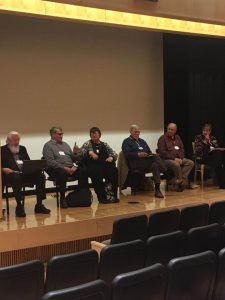
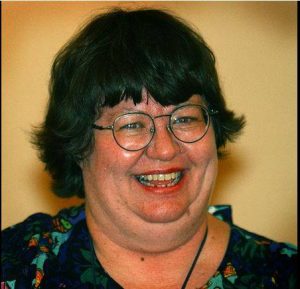
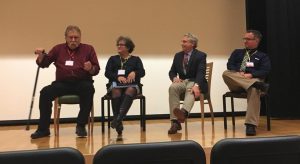
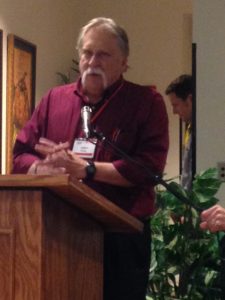
3 thoughts